Whether you believe in a flat Earth, the heliocentric model or you think the Earth is a large, spherical dodecahedron with an all mighty solenoid dictating life itself, Neil Degrasse Tyson’s words will always apply to you. “To be scientifically literate is to empower yourself to know when someone else is full of bullshit” (Tyson, 2017). No matter what you believe in, science will always be able to justify its actions, unless it’s well, “bullshit”. This is exactly what the 16th Century physicist, Johannes Kepler believed when he researched the Earth, Moon and universe as a whole. By doing so, he developed his 3 Planetary Laws of Motion and become the first and arguably “real” astrophysicist in all of history (Walding, Rapkins, Rossiter, 1999). Doing so, Kepler was able to make one of the largest contributions ever made to modern day Astrophysics. His planetary laws of motion answered many of the anomalies that the heliocentric model posed, however, they struggled to pin point what force of nature was exerted by the sun (Walding, Rapkins, Rossiter, 1999). This remained a prominent question within the society until 1687 when the incredibly egotistical yet, talented physician known as Isaac Newton entered the fray. Using Kepler’s Laws of Planetary Motion, Newton was able to derive his fundamental laws for the universe and like any arrogant mathematician who looked down on society, he named them after himself (Isaac Newton: The man who discovered Gravity, n.d.). Newton’s created law’s usurped those posed by Kepler as it worked under all conditions and answered questions that Kepler’s could not, however, if we really want to see how one arrogant scientist out did another arrogant scientist, we must start where it all began, Kepler’s First Law of Planetary Motion (Isaac Newton: The man who discovered Gravity, n.d.).
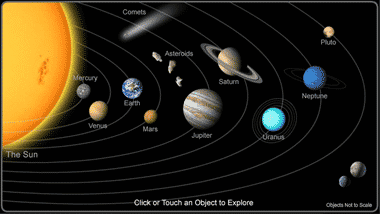
By using his late mentor’s data, Johannes Kepler observed the natural symmetry of the universe and saw each planet did not have a perfectly spherical orbit around the sun. This challenged the preconceived beliefs at the time as a majority of society believed that a planet’s orbits followed the perfect shape – a circle. (National Aeronautics and Space Administration, 2009) By understanding this concept, Kepler realised that a planet followed an elliptical orbit as oppose to a spherical one. This changed astrophysics as a whole because a circle has one central focus point where as an ellipse has two central foci points. This meant that the distance between the two foci points would determine how elliptical a planets orbit is, as oppose to it just being a perfect circle (High School Physics Explained, 2017). The measure of a planets elliptical path is known as its eccentricity. As shown by figure 1, Mercury has a more spherical orbit than Pluto which theoretically means its eccentricity should be of a lower value than Pluto’s. This is principal is indeed true as Pluto has an eccentricity of 0.25 which is greater than Mercury’s 0.21 (High School Physics Explained, 2017). This turned out to be a rather damming discovery as it also not only considered the sun to be in the centre of the solar system, but, it argued against the beliefs of traditional physicists, however Kepler did not stop analysing the data after developing one law of planetary motion, he stopped after his 3rd law. Enter Kepler’s 2nd and 3rd Laws of Planetary Motion.

By analysing, computing and understanding Tycho Brahe’s data, Kepler was able to conclude that the sun lied on one of the foci points within a planets elliptical orbit. (Walding, Rapkins, Rossiter, 1999). Through this analysis, he was able to deduce that a planets velocity is not constant, it in fact varies based on its distance from the sun. This meant that if a line was drawn from the sun to the planet, then the planet would sweep out the areas within the same time regardless of its distance. Consider Figure 2, it shows that at the point closest to the sun, the perihelion, is travelled at the same time as the point furthest away from the sun, the aphelion. This would not be possible if a planets orbit was constant as the greater distance would equate to a greater travel time. This inherent law and the further analysis of Tycho Brahe’s data helped build Kepler’s 3rd, and arguably greatest law, The law of Harmonies (Kepler’s Three Laws, n.d.)
In the year 1619, Galileo had what can only be referred to as a “firm rocking off his socks” as he could not fathom the theory developed by Kepler (Walding, Rapkins, Rossiter, 1999). Kepler’s 3rd Law mapped the period of a planet in relation to its radius by stating that, ‘the square of an orbital period is proportional to the cube of the semi-major axis.” (Kepler’s Three Laws, n.d.). By further testing, analysing and developing this model, Kepler was able to create a formula which used the idea proportions to map periods of orbitals and ultimately deducing the following formula;
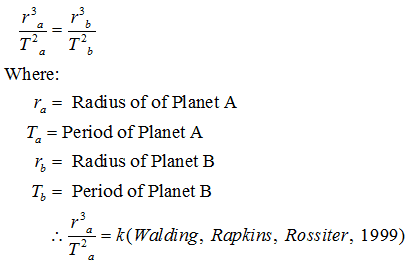
This law is able to easily pinpoint the period of any local object around a specific planet. For example if we wish the locate the radius of Jupiter in relation to the period and radius of Earth, we can use Kepler’s third law;

These three laws indeed shattered the beliefs of the time however, one problem had plagued Kepler’s ideas, he could not prove his findings. Data, calculations and other research had shown Kepler’s law worked however, no physicist could elaborate why it worked or what force kept these planets in an elliptic orbit until Isaac Newton entered the fray (High School Physics Explained, 2017).
Through an exaggerated tale of abusive apples, Newton was able to develop the idea of Gravity which answered questions Kepler’s Laws could not (Nix, 2015). Through the interpretation of Kepler’s laws, data and calculations, Newton was able to extend his notion of gravity towards planetary motion and synthesised its ideas to answer questions that Kepler’s Laws could not thus usurping his findings. If we truly want to understand how the mastermind that Isaac Newton is, we must start at the origin. His corresponding published book.
In his 1687 book, Philosophiae Naturalis Principia Mathematica, Newton observed the interrelationships between an objects mass and the relative force exerted by it (National Aeronautics and Space Administration, 2009) . When doing so, he was able to identify that the larger an objects mass, the stronger the exerted gravitational force was. By having this grounding in the theory of Gravity, Newton was able treat the moon as an object and juxtapose its acceleration with objects on Earth. By understanding his first law of motion, objects in motion will to stay in motion and objects at rest tend to stay at rest unless acted upon by an external force, Newton knew that the cause of the elliptical path was a result of an external force acting upon to object otherwise, it would continue travelling in a straight path (National Aeronautics and Space Administration, 2009). He then synthesised this idea with his knowledge in Gravity to objects maintain their orbit due to the centripetal force of gravity acting upon them from other objects (Kepler’s Three Laws, n.d.). This recent developed resulted in a formation of a new model where Gravity was a constant and the force was dependent on the product of two masses that were inversely proportional to the square of the distance between them.

With this derived equation, Newton could calculate the force of gravity acting between two objects of mass. For example, this formula can be used to calculate the force of gravity acting between the Earth and the Moon.
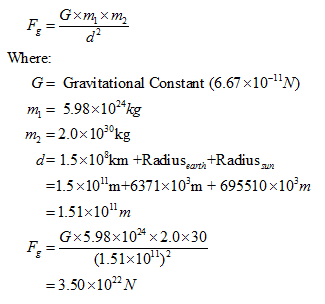
Kepler proposition that the sun moved planets by releasing “rays like wheel-spokes” which kept planet’s within their orbits was an interesting concept but it had little to no scientific backing which made many astronomers curious as to how this worked (Walding, Rapkins, Rossiter, 1999). By identifying that each planet exerted its own force of gravity that was dependent on its mass, Newton developed upon Kepler’s ideas and eventually usurped him by finding out that it was in fact the centripetal force of gravity exerted by the sun that caused planets to stay within their orbits (Kepler’s Three Laws, n.d.). This meant that the equation could be further derived to not only prove Kepler’s Law, but enhance it. The following equation was then derived by Newton;
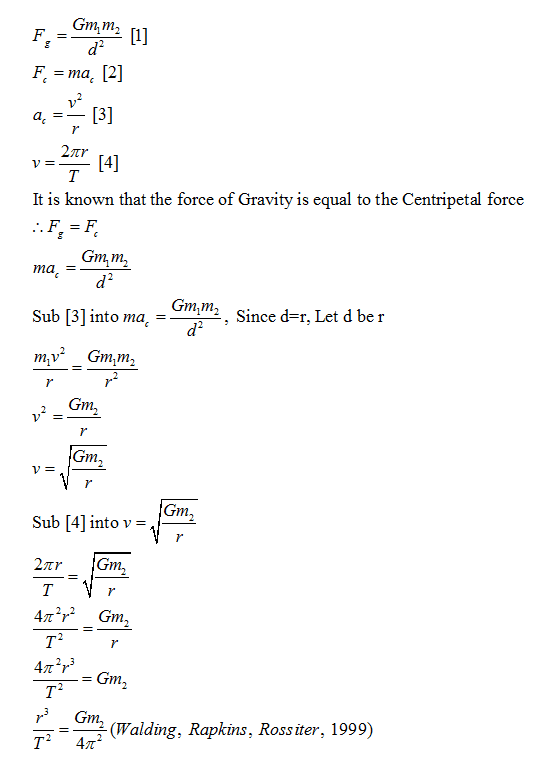
By deriving this formula and understanding that a centripetal force of gravity is what acted upon planets, Isaac Newton not only built on the foundations laid by Kepler, usurped his findings to prove his law worked. This aided physicists in the understanding of his law as there was now a reason as to how planets remained in orbit and a definitive proof to the functionality of his law.
In conclusion, Kepler was an outstanding physicist and for someone who lived in a time where the prominent belief was that the Earth was the centre of the universe, his findings, thought process and discoveries can only be labelled as revolutionary. His three laws of planetary motion answered many anomalies posed by the heliocentric model and revolutionised astrophysics as a whole however, it left a few unanswered questions. By deriving, analysing and understanding Kepler’s laws and data, Newton was able to conclude that the force of gravity played a vital role in astrophysics whilst also being able to prove Kepler’s third law of planetary motion. This built upon Kepler’s ideas and understandings but answered the two anomalies that Kepler could not, thus usurping his findings and bettering astrophysics as a whole. Neil Degrasse Tyson did once say, “To be scientifically literate is to empower yourself to know when someone else is full of bullshit” (Tyson, 2017). This idea may apply to the everyday flat-earther but when it comes to understanding how, when or where Newton usurped Kepler, it cannot be called “bullshit”.
The Vacuum Cleaner from Outer Space
The term “black and white” refers to something that is clear cut and straight forward. Something like eating bread is “black and white”, brushing your teeth is “black and white’, but understanding the physics behind a black hole doesn’t fit the definition of “black and white”. To this very day, physicists argue about the properties of a black hole and in order to grasp even the basics of the basics, we must have a firm understanding of what makes it “black”, how they are formed and how light changes as it nears a black hole. Thus, inherently grasping the basics of the not-so “black and white physics” of blackholes.
Blackholes are rather complex objects that are shrouded in mystery, however, one of the few facts we know for certain is about their formation. Black holes arise as a star within our universe collapses. In a standard star, the force exerted by the nuclear fusion occurring within its core balances with the external gravity acting upon it. This balance is what keeps it stable, however, when a star dies this balance is disrupted with it favouring the external gravity. This causes it to implode and within a fraction of a second, the star releases large amounts of energy whilst condensing its mass into a much smaller object (Kurzgesagt – In a Nutshell, 2015). The mass of the condensed object, the remnant star, is a variable as it depends on mass of the parent star however, there are many stars that can form from a remnant star such as red giants, white dwarfs etc. But one thing these stars have in common, is that the outwards gravity and the internal force being exerted is at equilibrium thus preventing the mass to further condense (Khan, n.d.). This scenario remains true until the topic of black holes is reached, black holes form when a star with a mass greater than 3x that of the sun collapses. When this happens, the outward gravity is much stronger then the resistance force and no force can prevent the mass of the star to collapse in on itself (Kurzgesagt – In a Nutshell, 2015). This blackhole, or in other words, dead star, has a rather grim beginning but what’s grimmer are the misconceptions surrounding these blackholes.
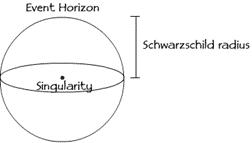
It is commonly believed that black holes are similar to the monsters we keep within our households – the fabled vacuum cleaner (Crash Course, 2015). This assumption is inherently ludicrous as when it comes to a vacuum cleaner, the physics and interrelationship are black and white, but, when it comes to black holes, not so much. We believe this assumption to be true as blackholes have large, strong gravitational fields which we perceive as something that would absorb all matter into it, similarly to a vacuum cleaner (Crash Course, 2015). This idea is inherently flawed as when a black hole is formed, it follows the principals of gravity thus making its strength weaker as distance increases (Walding, Rapkins, Rossiter, 1999). This is true to such an extent that if the sun within our very own solar system were to be replaced by a black hole, there would be no drastic changes to Earth assuming we found another source that generated heat (Crash Course, 2015). The force of gravity also depends on where you are located along the black hole. Consider Figure 3, it displays the three main regions of a black hole, the Event Horizon, the Schwarzschild Radius and the Singularity (Walding, Rapkins, Rossiter, 1999). At each of these regions the force acting upon the object due to the black hole changes, meaning as an object approaches a blackhole, the force acting upon it increases as its distance from the singularity decreases
(Walding, Rapkins, Rossiter, 1999). This means that as an object nears the singularity point within the black hole, the force of gravity acting upon that object due to the black hole increases thus increasing its escape velocity and complicating the science related to their existence (Walding, Rapkins, Rossiter, 1999).
The event horizon marks the bleak end of any object nearing a blackhole. It defines the boundary of the region of space surrounding the blackhole. It is known that outside the blackhole, where vesc represents the escape velocity and c represents the speed of light (Event Horizon, n.d.). As the object nears the event horizon, the escape velocity increases, meaning it continues to grow closer and closer to the speed of light until it reaches the event horizon. At this point, the escape velocity equates to the speed of light, meaning that the only object that can still escape is light itself. Once an object has passed this point, it becomes impossible to escape as it enters the Schwarzschild radius (Walding, Rapkins, Rossiter, 1999).
The Schwarzschild radius is the distance between the singularity and the event horizon. Once entered, the force of gravity pulls on an object to a degree where it physically becomes impossible to escape. Consider the black hole, GU-Muscae. It has a mass equal to 7 times that off the sun and a radius of 21,000 meters (Black Hole Encyclopedia, n.d.), calculate the escape velocity once the event horizon has been breached:
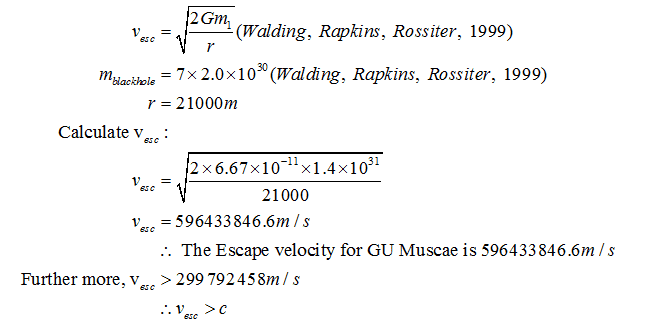

Since the escape velocity is greater than that of light as the object nears the singularity, nothing can be perceived by the human eye – or any other eye in general. This is because light itself does not escape a blackhole meaning it is never reflected into our eyes (Crash Course, 2015). This creates the illusion that they are black, we cannot see them. This essentially what makes a black hole, black, and the physics of a black hole, not “black and white”, but one more thing must be factored in in order to fully understand the essence of the blackhole. Their unbelievably large amount of mass.
Black holes have such a large mass that they not only absorb light, but they warp spacetime itself (Crash Course, 2015). Einstein’s general theory of relatively shows that when an object with a large mass, similarly to a black hole, warps space, it also warps time. By warping spacetime due to its sheer mass alone, black holes are able to create what is known as a gravitational shift. Earlier it was established that as an object approaches the event horizon, it needs to have an escape velocity near, if not at the speed of light in order to escape. This was due to the gravitational force being stronger as the distance lessened. This inherently ties into Newtons Second Law of motion which states that an objects acceleration is directly proportional to the magnitude of the net force, or in other words, F=ma (National Aeronautics and Space Administration, 2009). This means that as the force acting upon the object increases, its acceleration would increase proportionally meaning it would speed up. This obviously means that from the object’s perspective, as it grows closer and closer to the singularity point, there is a gravitational blue shift as it speeds up however, this is different from an outside perspective (Crash Course, 2015). If you were watching an object fall into a blackhole, you would think it would fall in an instant, but it would take a considerable amount of time from your perspective. This is because of something known as the gravitational redshift. As the light grows closer and closer to the singularity point, it loses energy to the gravitational pull of the black hole. This inherently stretches the wavelength of the light out and since the energy of light is tied to its wave length, light with a longer wave length has less energy. This elongated fall of an object would abruptly end once it passes the event horizon as light would physically not reflect of it, meaning it would not enter your eyes thus making it black in the truest form (Walding, Rapkins, Rossiter, 1999)(Crash Course, 2015).
In summary, the physics of a blackhole isn’t as “black and white” as eating toast in the morning or going out for your daily jog. The most basic of concepts such as a black hole’s birth, how light interacts around the high gravitational field and ultimately what makes them, well, “black”, is one of the only areas of the field that aren’t heavily debated (Khan, n.d.). For the most part, the nature of black holes are an anomaly to us, they cannot be observed by the naked eye and they push our understanding of physics to their limits however, understanding the bare basics of what makes them “black” assist in our grasping of the “not so black and white” physics of black holes.
References
Rapkins, G., Rossiter, D, & Walding, R. (1999). New Century Senior Physics: Concepts in Context. Oxford, Melbourne
National Aeronautics and Space Administration. (2009). The Science: Orbital Mechanics. Retrieved from https://earthobservatory.nasa.gov/features/OrbitsHistory/page2.php
Kepler’s Three Laws. (n.d.). Retrieved from https://www.physicsclassroom.com/class/circles/Lesson-4/Kepler-s-Three-Laws
Isaac Newton: The man who discovered Gravity. (n.d.). Retrieved from https://www.bbc.com/timelines/zwwgcdm#zw7987h
Nix, E. (2015). Did an apple really fall on Isaac Newton’s head?. Retrieved from https://www.history.com/news/did-an-apple-really-fall-on-isaac-newtons-head
TerreStar-1. (2019). Retrieved from https://www.n2yo.com/satellite/?s=35496
Khan, S. (n.d.). Newton’s Law of Gravitation Review. Retrieved from https://www.khanacademy.org/science/ap-physics-1/ap-centripetal-force-and-gravitation/newtons-law-of-gravitation-ap/a/newtons-law-of-gravitation-ap1
High School Physics Explained. (2017, January 22). Kepler’s Three Law’s Explained [Video file]. Retrieved from https://www.youtube.com/watch?v=kyR6EO_RMKE&t=624s
Tyson, D.N. (2017, May 27). Niel deGrasse Tyson [Tweet]. Retrieved from https://twitter.com/neiltyson/status/868497205308657665?lang=en
Kurzgesagt – In a Nutshell. (2015, December 15). Black Holes Explained – From Birth to Death [Video file]. Retrieved from https://www.youtube.com/watch?v=e-P5IFTqB98&t=176s
Crash Course. (2015, September 15). Black Holes: Crash Course Astronomy #33 [Video file]. Retrieved from https://www.youtube.com/watch?v=qZWPBKULkdQ
Schwarzschild Radius. (n.d.). Retrieved from http://astronomy.swin.edu.au/cosmos/S/Schwarzschild+Radius
